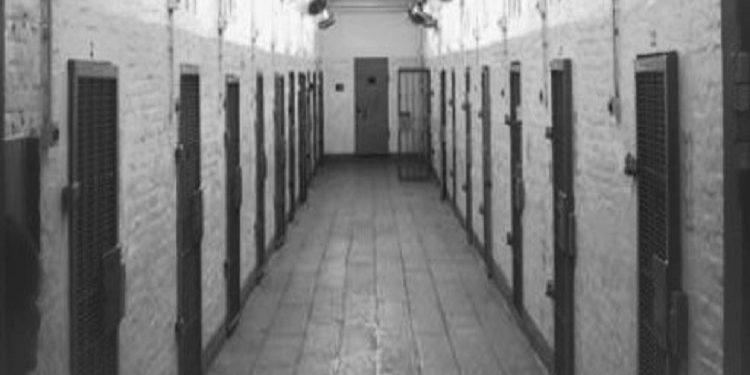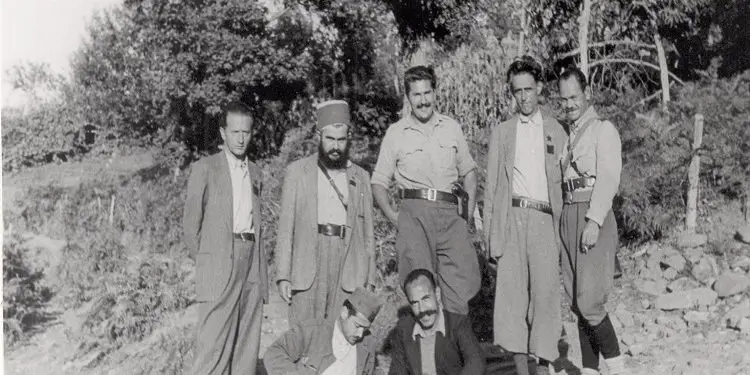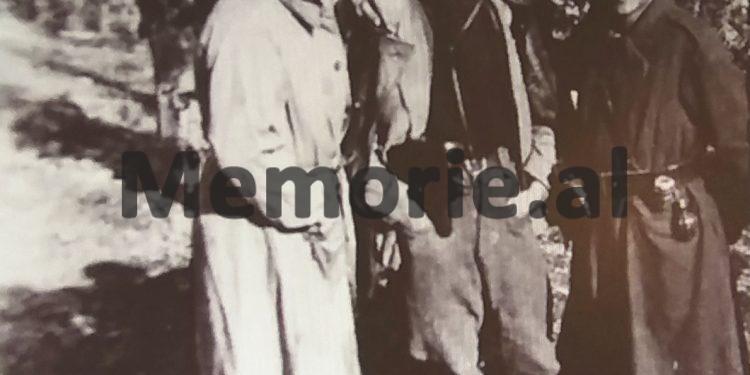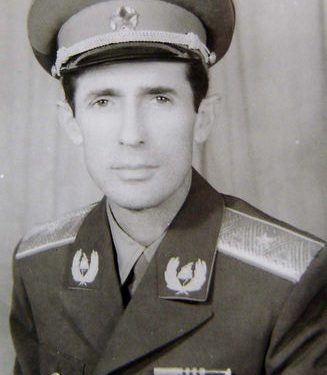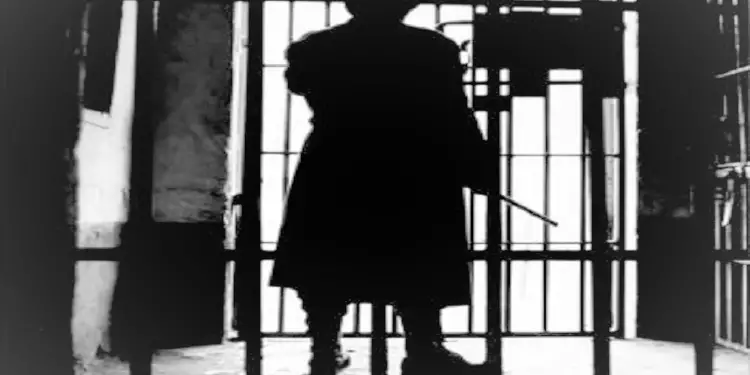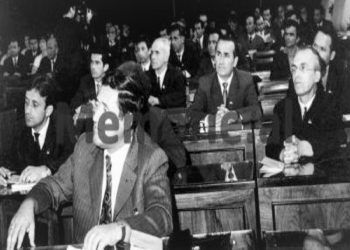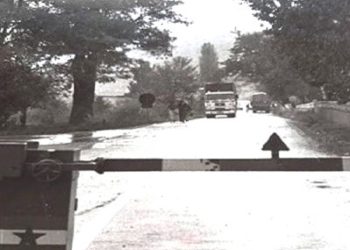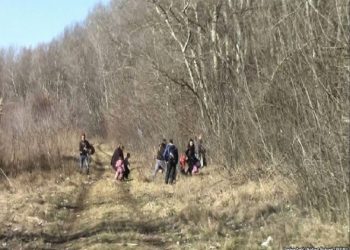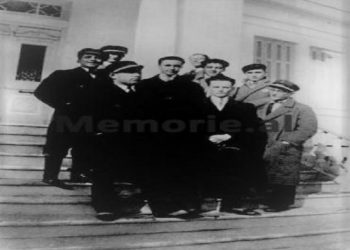From Agim Musta
Part twenty-five
Memorie.al / On the fourth anniversary of the passing away of the well-known historian, researcher, writer and publicist Agim Musta, (July 24, 2019), former political prisoner, his daughters Elizabeta and Suela, gave him the right to exclusivity for the publication, by the online media Memorie.al, of one of the author’s most prominent publications, such as the ‘Black Book of Albanian Communism’. This work contains numerous data, evidence, facts, statistics and arguments unknown to the general public, on communist crimes and terror in Albania, especially against intellectuals, in the period 1945-1991. The publication for the first time of parts of this book is also the realization of one of the bequests of the historian Agim Musta, who, from the beginning of 1991 until he passed away, for nearly three decades was engaged with all his powers, working to raise collective memory, through book publications and publications in the daily press. All that voluminous work of Mr. Agim Musta, concretized in several books, is a contribution of great value to the disclosure of the crimes of the communist regime of Enver Hoxha and his successor, Ramiz Alia. A good part of the publications of Mr. Agim Musta, is also translated into English. Thanking the two daughters of the late Musta, who chose Memorie.al, to commemorate their father, from today we are starting the publication, part by part, of the “Black Book of Albanian Communism”.
Continues from last issue
-Portraits of fellow sufferers-
(1945-1991)
- Places where candles should be lit and tombstones erected
Beginning after the end of the First World War, by order of the Comintern, the “Squads of Lenin’s sons” were created in the countries of Central and Eastern Europe, which the people called “Death Squads”. The members of these teams were born sadists, or professional criminals, released from prison after the collapse of the Austro-Hungarian and German empires.
The “Squads of Lenin’s Sons” were led by German, Austrian, Hungarian, Greek, Polish, Bulgarian, Lithuanian, Latvian, Estonian, etc. fanatical Communist militants who had participated in the October Bolshevik Revolution. After preparing for several months in Russia, to commit terrorist acts, in 1919, they were sent by the Comintern to their countries to annihilate the enemies of communism.
The “death squads” operated in great secrecy to kill intellectuals and important persons, whom they judged to be obstacles to the establishment of Soviet power. As tools in their criminal activity, they used firearms, explosives, cold weapons, sophisticated poisons and money-gold, which Moscow did not spare for such work.
The “death squads” were not accountable to any party forum. Their leaders reported directly to the Secretary of the Comintern in Moscow. Within 6 months of 1919, the “Squads of Lenin’s Boys”, in Hungary, executed 500 personalities, from all areas of Hungarian life.
The “Death Squads” were also created in Albania after the establishment of the Communist Party of Albania on November 8, 1941. The leaders of the “Death Squads” were prepared by the Yugoslav emissaries. The members of these teams were unknown, not only by simple partisans, but also by the senior cadres of the Communist Party.
Here is what Masar Shehu, former deputy commissioner of the Partisan Group of Peza, claims: “I was not aware of the actions of that team and of the members who were part of it. I had heard that it was led by ‘Shulja’ (pseudonym of Kristo Themelko) and he did not account to anyone for the murders he committed”.
Peza’s “death squad” carried out its activities in Tirana, Durrës, Kavajë and Peqin. Many innocent citizens have been kidnapped and cruelly tortured by this team. Among them we are mentioning university students Besnik Çano and Qeramudin Sula, who were massacred in September 1943. Their corpses were thrown into the abyss, near the village of Cikallesh.
In the district of Korça, the “Death Squad” was led by the former terrorist, Niko Çeta. This team massacred in October 1943, Baba Zylfon of Teqe i Turani, together with 3 other people, who were in the Teqe that night. The victims abducted by this team, in different places of the Korça district, were sent to Shipckë village, 20 km. southwest of the city. There, they were cruelly tortured, cutting their limbs, genitals, ears, fingers, etc. with knives, machetes and axes.
After the establishment of democracy, a large amount of skeletons with severed heads were found in the Shipcka stream, and in some bones of legs and hands, there were nails embedded in them, this fact proves the crucifixion of the victims before death. These skeletons prove the words that circulated from ear to ear, that in Shipckë village, during the years 1942-1943, there was a slaughterhouse of people, where many innocent people were massacred by the “Death Squad” of the Communist Circle of Korça.
In Gjirokastra District, the “Death Squad” was led by Pertef Kokona and Sherif Baboçi. The place where the victims were kidnapped was Ura e Kardhiqi, 14 km. north of the city of Gjirokastra. According to the information he received from the Communist Circle of the city, the “Death Squad” lay in wait near the Kardhiqi Bridge and raped the victim who was to be executed.
The detained person was escorted to a hut near the village of Plesat and there, after cruelly torturing him, he was killed and thrown into a stream located near the hut. In 1943, the 65-year-old lawyer Petro Dilo, the mayor of the municipality, Riza Kardhiqi, the sub-officer of the police, Eqerem Angoni, the merchant Mihal Lito, and many others were killed here.
In May 1943, at Ura e Kardhiqi, Ali Këlcyra, the leader of the “National Front” for South Albania, was kidnapped by the “Death Squad”. The communists, knowing the popularity that Ali Këlcyra enjoyed in the Gjirokastra region, did not immediately destroy him, as they usually did with other victims, but kept him isolated for several days, to see the reaction of the people to their action.
When the news of the kidnapping of Ali Këlcyra was revealed, several hundred armed fighters from the “Balli Kombëtar” addressed the communist headquarters of the Gjirokastra District, threatening massive revenge if Ali Këlcyra was killed. The Communist District of Gjirokastra, afraid of the furious reaction of the “National Front”, ordered the release of Ali Këlcyra and the distribution of a tract, which stated, among other things, that; Ali Këlcyra was not kidnapped at Ura e Kardhiqi, to kill him, but to “hold talks”.
In the District of Vlora, the “Death Squad” was created in May 1943, by the secretary of the communist district, Hysni Kapo. The members of this team gathered in a dark cave, near the village of Terbaç, which is called “Shiroka’s Cave”. The commander of the team was appointed Mehmet Jaho with the nickname “Warrior Bolena”, who was later replaced by Shyqyri Alimerko.
From this team, a large number of people were annihilated, kidnapped or killed in treacherous ambushes. The favorite prey of the “Death Squad” of the Vlora District have been the fighters of the “Old Squad” of Vlora, members of the “Youth” communist group and anti-communist nationalists.
We are mentioning some of the victims that the “Death Squad” executed in Vlora district: Neki Ymeri, Xhafer Dalani, Mynir Xhindi, Shaskë Rustemi, Gjysh Premtaj, Flamur Xhindi, Rrapo Premti, Veledin Kocaqi, Sulejman Aliaj, Arap Shenaj, Namik Numani, Shefqet Nuraj, etc. The victims, who were caught, alive or wounded, were barbarically slaughtered (as in the case of Meço Çobaj, who was burned alive in the woodpile) and thrown into a stream, between Tërbaç and Brataj streets.
Due to its geographical position, the city of Elbasan was given special attention by the Communist Party of Albania, since its foundation. On November 20, 1941, the first communist cell was formed in Elbasan, consisting of 8 members, 5 of whom had been members of the “Youth” Communist Group, founded by Sadik Premte and Anastas Lulo, with the nicknames “Jhepi ” and “The Crow”.
The delegate of the Central Committee of the Communist Party of Albania, who led the meeting of the cell, was Ramadan Çitaku, known as a supporter of the Yugoslavs and as the left wing of Miladin Popović and Dušan Mugoša. Ramadan Çitaku (under the pseudonym “Baca”) served not only as a translator of the emissaries of the Yugoslav Communist Party, sent to Albania, during the period 1941-1944, but he was also sent with special services, by the Yugoslav emissaries, to various countries Albania.
In April 1942, Ramadan Çitaku, together with Vasil Shanto (Montenegro by origin), go to Elbasan and form the “Death Squad”. The devout communist Petrit Hakani was appointed as its commander. During the years 1942-1943, in Labinot village of Elbasan, a large part of the members of the Central Committee of P.K. of Albania and the General Staff of the National Liberation Army.
The “Death Squad” was assigned as a primary task, by Ramadan Çitaku, the destruction of the cadres of the Elbasan district party, who had had friction with Enver Hoxha and Milad Popovici.
It should be noted that most of the cadres of the Communist Circle of Elbasan came from the “Communist Group of the Young”. Mehmet Bajraktari – the former first commander of the guerilla unit and his brother, Hasan Bajraktari, the former partisan battalion commander, were killed back to back. The two Bajraktari brothers, who were from Kosovo, had told Enver Hoxha and Miladin Popovic that they were for the union of Kosovo with Albania.
The “death squad”, in addition to bullets, poison and knives, also used reporting to the occupying police to destroy unwanted elements. Through the report, Tomor Sinani, political secretary of the District of the Communist Party of Elbasan, and Fetah Ekmekçiu, the treasurer of the General Staff, were eliminated.
Sadik Premtja (“Pocket”), in an interview he gave to the French magazine “Sou le drapeau du socialisme” (Under the banner of socialism), in 1956, in Paris, stated: “From the Communist Youth Group, during in the years 1942-1944, more than 100 of its members were treacherously killed, by order of Enver Hoxha’s wolf kennel.
Many nationalist intellectuals have been killed by Elbasan’s “Death Squad”, such as; doctor Orizaj, Xhafer Begolli, etc. The place where the victims were tortured and executed was a house, near the Spas of Elbasan.
Note: “Death squads” also existed in the prefectures of Shkodra and Berat, but due to lack of information, we cannot write about the crimes committed by them.
- Hunger strikes in prisons and forced labor camps during the communist dictatorship in Albania, 1945-1991
Hunger strikes were used by the political prisoners of Albania as a means of protest against the use of violence and the violation of the most basic rights of political prisoners, by the personnel of the camps and prisons, which was under the direct dependence of the Ministry of Internal Affairs. The hunger strike was the prisoner’s last weapon against the arbitrary violence of prison and forced labor camp commanders, who often did not respect even the regulations drawn up by the Camp Directorate and Prisons.
We can affirm with complete conviction that in all 100 prisons and forced labor camps that existed in Albania, during the Enverian dictatorship, hunger strikes, individual and collective, were continuously carried out, which were suppressed with barbaric violence, or have ended with the death of hunger strikers, such as the case of the former Minister of Education, Xhevat Korça, in the prison of Burrel, of the lawyer Vasil Zisi in the prison of Korça, of Sami Emir in the prison of Gjirokastra, and of a French archaeologist for underwater research in the cells of the Security of Vlora, and many others who have remained unidentified. Often, hunger strikes began already in the cells of the investigation, when the arrested person called himself completely innocent, his arrest arbitrary and absurd.
Usually, the hunger striker, who refused to receive food during the investigation, was subjected to barbaric violence in order to force the arrested person to stop the hunger strike. When the arrested person, who declared a hunger strike, was an important functionary (VIP), of the party-state and the investigators thought that they would discover some important hostile activity, they sent the defendant to the prison-hospital of Tirana, where he was kept isolated in separate rooms, tied hand and foot, making serums to keep him alive.
In this case, it is worth mentioning the case of the high functionary of the party-state, Xhavit Qeses, who continued his hunger strike, in the hospital-prison of Tirana, for 107 days, by force-feeding him serums. The hunger strike was also used by sick political prisoners, who were forced to work, regardless of the camp commanders or doctors’ reports.
In the winter of 1965, in the prison camp of the Bulqiza mine, the command of the camp forced over 500 prisoners sick with flu with a temperature above 38 degrees to work. The sick prisoners, when they returned from work, refused to take the food and overturned the food containers. The hunger strike involved all the prisoners and continued for 3 days. The command of the camp, afraid that the situation could be complicated even further, by order of the Ministry of Internal Affairs, decided to let all the prisoners who had a temperature above 37 degrees rest in the camp.
Similarly, in other camps, many sick convicts who were forced to work have gone on hunger strike, such as; Qazim Puka, Dilaver Radëshi and others. Convicts have also gone on hunger strike demanding compliance with the prison regulations from the command personnel themselves, who were trampling on them with both feet to make their life in prisons blacker and more unbearable. Individuals also went on hunger strike for intimate personal reasons, which no one knew and many of them died without knowing the reason for their strike, such as: Izet Hadëri in Tirana prison, Cufe Mullai in Vlora prison, Ilia Kondololi in the Vlashuk camp, etc.
When prisoners refused to go to work, mass violence was used on them, and the prisoners responded to the violence with mass hunger strikes. This is what happened in 1952, in the Kuçova airport forced labor camp, where 600 abused prisoners went on a hunger strike that lasted 7 days. The same thing happened in the Gjadri camp in 1955, where several hundred Greek prisoners went on hunger strike to avoid going to work. Not only violence was used against them, but fire was also opened by the guards, killing some unfortunates, while many others sacrificed themselves, jumping on the fence wires.
The hunger strike was also used by the prisoners as a form of protest against the traps that the prison command organized for the disposal of elite prisoners. This is what happened in Beden Camp, in 1947, where the commander, Haxhi Pela, organized a conspiracy to kill more than 20 imprisoned intellectuals, allegedly because they would escape when they went to fill water outside the camp’s perimeter. The trap set by the sadist Haxhi Pela was de-conspired and the prisoners announced a hunger strike, demanding life insurance from the Ministry of Internal Affairs.
Haxhi Pela was transferred to another country and the prisoners were told that he was allegedly punished for the stupid things he had to do: Hunger strikes became more frequent in prisons and forced labor camps after the death of the dictator Hoxha in 1985 The demands of the prisoners who went on hunger strike, after 1985, began to have a political character. In many prisons and camps with forced labor, such as in Burrel, Spaçi, Qafë Bari, Përparim (Saranda), etc., the prisoners demanded the review of unjust court decisions, the prohibition of forced labor that contradicted the decisions of the UN -, for human rights and other democratic demands, which were contrary to the communist legislation of the time.
The hunger strikes of political prisoners reached massive proportions in 1990 and especially after the visit made to Albania by the Secretary General of the United Nations, Mr. Peres de Cuellar. The ruined state of the Dictatorship of the Proletariat in Albania had come to an end. The long-awaited lira was knocking heavily on the iron doors of Albanian prisons, which for half a century had turned into symbols of terror and death.
On September 20, 1991, 90 political prisoners from all over Albania announced a hunger strike on “Rrugë e Kavaja” at the handball stadium called “Uncle Tom’s Park”. Under the pressure of the hunger strike, which continued for 10 days, the Albanian Parliament, on September 30, 1991, unanimously voted to acquit all political prisoners and those convicted by the communist dictatorial regime. Below we are publishing the names of former political prisoners participating in the hunger strike of September 1991:
1 Viktor Martini, 2. Haki Bulku, 3. Agron Dakaj, 4. Vladimir Xhelo, 5. Gjergji Qonuku, 6. Bardhy1 Lohja, 7. Demir Abazi, 8. Paulin Ndoja, 9. Kadri Rama, 10. Maqo Karaj, 11 Ferdinand Metaj, 12. Gëzim Behaj, 13. Fatmir Lekasi, 14. Agron Talo, 15. Hysen Tabaku, 16. Ilirian Çerepi, 17. Hysen Daka, 18. Maliq Dibra, 19. Tomor Gora, 20. Haxhi Sula, 21 Shkëlqim Basha, 22. Ilir Malaj, 23. Agron Kalaj, 24. Ded Matosha, 25. Agostin Çoku, 26. Martin Mustafaraj, 27. Bedri Blloshmi, 28. Napoleon Koleci, 29. Hasan Durishti, 30. Odhise Mertiri, 31 . Dhimiter Dhaskali, 42. Alfred Konopi, 43. Agron Alimadhi, 44. Dhimitër Paskali, 45. Alfred Konomi, 46. Arben Jaho, 47. Arben Driza, 48. Sami Lushaku, 49. Haxhi Baxinovsi, 50. Rapush Çela, 51 Reshat Qosja, 52. Islam Cenko, 53. Paskal Simaku, 54. Sulejman Doda, 55. Qazim Toro, 56. Andra Barbullushi, 57. Skënder Bariu, 58. Xhemil Demi, 59. Nikolin Keka, 60. Ahmet Hogu, 61 Tom Beqari, 62. Skender Ymeri, 63. Shtjefën Lacuku, 64. Medi Dakoli, 65. Ramadan Demiri, 66. Pjetër Logoreci, 67. Shkëlqim Kurti, 68. Veli Haxhiraj, 69. Arben Sengla, 70. Halim Qejvani, 71 See Stërmasi, 72. Ali Kulla, 73. Ylli Iliazi, 74. Emror Koleci, 75. Gjeto Vukçaj, 76. Qazim Visha, 77. Besim Valteri, 78. Mezan Abazi, 79. Fatos Kërluku, 80. Adem Xhaferri, 81 Mersin Vlashi, 82. Veniamin Ranxho, 83. Fadil Daja, 84, Hysen Haxhiaj, 85. Haxhi Malaj. Memorie.al
The next issue follows




